Gharials under threat
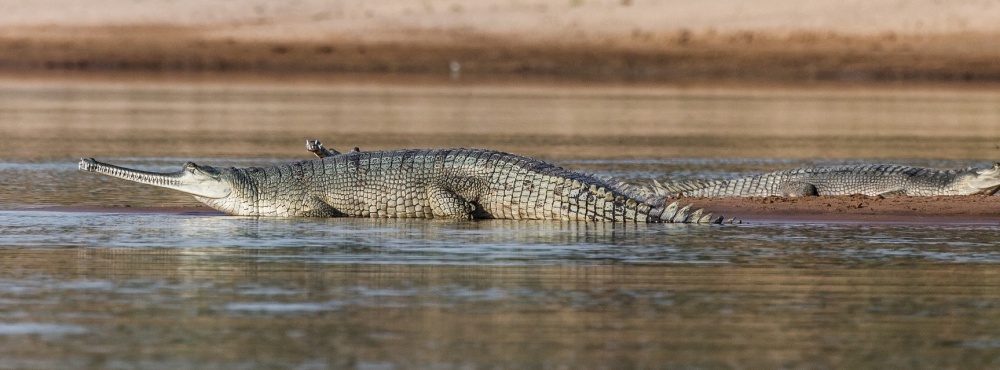
The gharial is one of the rarest large animals of the Indian subcontinent and one of the most endangered crocodilian species in the world. The total population is estimated at less than 1,000 adult individuals. Not even the tiger—the flagship species of Indian wildlife conservation—is as critically endangered in India as the gharial!
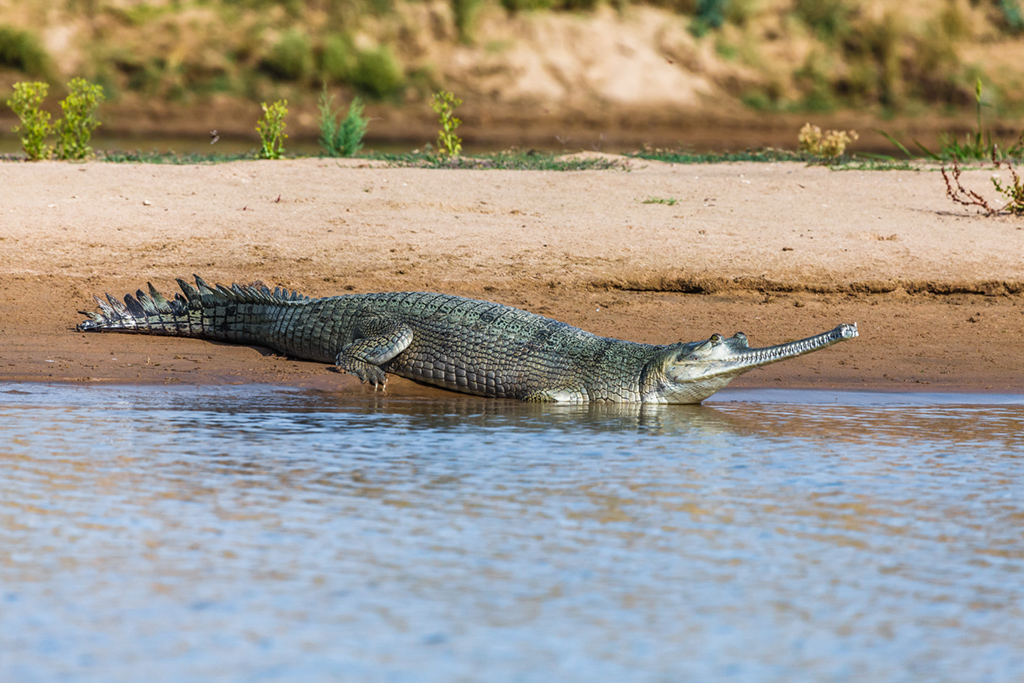
A gharial on the Chambal River. Photo: Miroslav Bobek, Prague Zoo
The gharial is an evolutionarily unique crocodilian with exceptional scientific, ecological, and cultural value. It is the last surviving member of an ancient and highly distinctive group of crocodilians that lived on Earth millions of years ago. It differs from its relatives in many ways—including its specialisation in fish hunting, reflected in its extremely long, slender jaws, and its pronounced sexual dimorphism, with adult males developing a prominent bulbous growth on the snout. With an impressive body length of up to six metres, the gharial ranks not only among the largest crocodilians in the world, but also among the largest predators in India’s rivers.
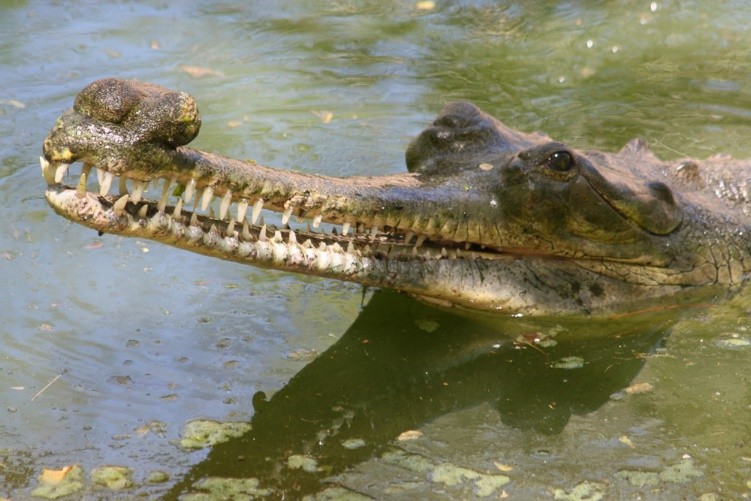
Adult male gharials have a prominent cartilaginous growth on the tip of their snout, known as a ghara. This structure plays a crucial role during courtship: it is used in elaborate male displays, the production of water geysers and bubbles, and in amplifying and modulating vocalisations. Photo: Ivan Rehák, Prague Zoo
Originally, gharials inhabited the river basins of South and Southeast Asia ranging from Pakistan to Myanmar (including the Indus, Ganges, Brahmaputra, Mahanadi, and Irrawaddy river systems). Today, however, they are critically endangered. One of the few remaining populations lives in the Chambal River in northern India, where we are actively involved in conservation efforts.
The historical decline of the gharial
The construction of dams and irrigation canals, the regulation and modification of river systems, concrete embankments, and pollution from industrial runoff have all contributed to the near-total loss of suitable habitats for gharials. Historically, unregulated hunting and accidental deaths in fishing nets have also played a major role in the species’ decline.
The first major gharial crisis dates back to the 1970s, when the wild population was estimated at only around 200 adult individuals—a stark contrast to the estimated 5,000–10,000 that lived in the wild during the 1940s. In response, conservation initiatives were established, primarily based on head-starting, with hundreds to thousands of captive-bred individuals being released into the wild once they had grown large enough. These efforts initially succeeded in boosting population numbers, and at one point, the species was even declared saved. However, the absence of a comprehensive, long-term programme focused on protecting natural habitats and engaging local communities led to yet another population decline. One by one, isolated populations collapsed.
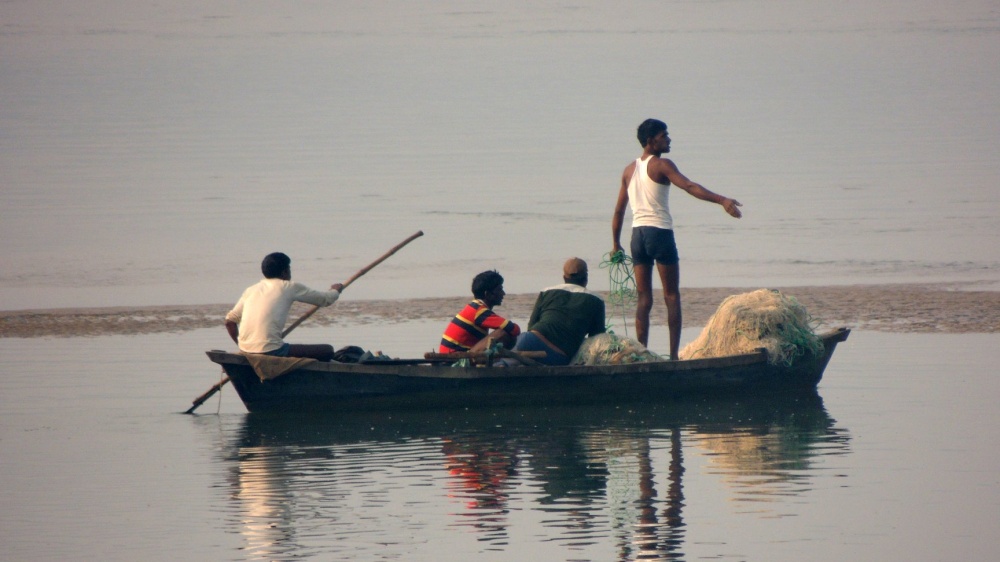
Unregulated fishing and illegal hunting of gharials were among the main threats to the species in the past. Today, local fishermen assist in the capture of gharials so that radio transmitters can be fitted to them as part of zoological research. In doing so, they contribute to the protection of the species while also helping to foster interest in endangered wildlife within their communities. Photo: Gharial Ecology Project
In the mid-2000s, field surveys revealed that the status of wild gharial populations was at its worst since the 1970s. In many rivers, they had disappeared completely or ceased to reproduce. This led to the launch of a new conservation initiative with the involvement of international scientists and conservationists. However, at the turn of 2007–2008, a new catastrophe struck just as renewed efforts to save the species were getting underway. In the Chambal River—home to the vast majority of the world’s remaining gharials—more than a hundred adult individuals died in a mass mortality event. Almost all were found along a several-kilometre stretch in the lower reaches of the river. Dissections of the dead individuals revealed kidney damage and associated gout—a condition caused by the build-up of uric acid in joints and tissues. Poisoning was identified as the likely cause, although the specific toxins and their source could not be determined. One possible explanation is that the gharials consumed contaminated fish. At the same time, unusually cold weather in the area may have significantly slowed the animals’ metabolism, reducing their ability to cope with the toxins.
Current situation
Today, 80 % of the world’s gharial population lives in the Chambal River. Thanks to conservation efforts, their numbers have started to rise again, and estimates from 2024 suggest there are around 700 adult individuals. For comparison, at the turn of the millennium, only 150 adult gharials were recorded in the Chambal. It is, however, important to note that males are significantly outnumbered by females.
Outside the Chambal, small populations of gharials survive in other parts of India and Nepal—including Katarniaghat Wildlife Sanctuary, Corbett National Park, the Gandak River, and in reintroduced populations in the River Ganga at Hastinapur Wildlife Sanctuary and in the Beas Conservation Reserve of Punjab. Several breeding centres are also operating in India.
Unfortunately, even within protected areas, gharials are not entirely free from threats. Illegal fishing deprives gharials of food, while fishing nets pose a deadly threat. Pollution and non-native fish species also present serious risks. A particularly severe problem is illegal sand mining along riverbanks, which inadvertently destroys nesting sites.
A separate and increasingly pressing issue is ongoing development, which has now reached even the Chambal. In many areas that were once peaceful strongholds for gharials, there is now heavy traffic. Roads have been built along the riverbanks, and gharials are forced into close contact with humans. Unfortunately, many local people have a distorted view of their river-dwelling neighbours, which does little to support the cause of gharial conservation.
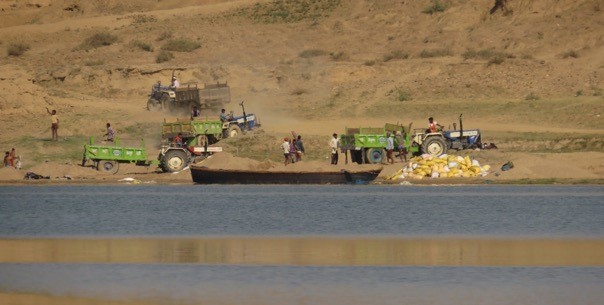
Illegal sand mining. Photo: Gharial Ecology Project
Threats in more detail
Water infrastructure and changes to river flow regimes. River damming has far-reaching impacts on entire ecosystems. For gharials, it primarily disrupts their ability to migrate along the river. Artificial fluctuations in water levels also negatively affect their movement, foraging, and nesting behaviour. Water infrastructure is likely one of the reasons gharials have disappeared entirely from some parts of their former range.
Illegal sand mining. Sand extraction causes severe degradation of riverbanks and robs not only gharials, but also endangered riverine turtles, of the sandy beaches they rely on for nesting. The scale of mining is essentially industrial. The sand is sold in urban centres and used in construction. Since the Chambal River forms a border between states, it is common for sand to be extracted from one bank and transported by boat to the opposite side, which falls under a different jurisdiction. Enforcement of regulations is virtually non-existent.
Fishing and poaching. The primary threat lies in fishing nets: gharials can become easily entangled in them and drown. Shredded netting may also wrap around their jaws, preventing them from feeding and leading to starvation. There have even been documented cases of people cutting off the jaws of gharials whose snouts had become tangled in nets. While such injuries may not kill the crocodilians immediately, they ultimately prove fatal, as the animals are left unable to hunt. In addition, gharials themselves are targeted by poachers—their skins are used to produce luxury goods, and their eggs are considered a delicacy.
Introduced fish species. Tilapia, originally from Africa and widely farmed for commercial purposes, have escaped into rivers in several areas and now form a significant part of the gharial’s diet. These fish pose a risk primarily because of harmful substances that can accumulate in their tissues—such as hormones, pharmaceuticals, heavy metals, and other toxins.
In addition to human-driven degradation of riverbanks, the encroachment of dense vegetation has also had a negative impact on gharial nesting. However, clearing this vegetation and depositing fresh sand have proven effective in restoring suitable nesting sites in some areas.
ZOOPRAHA.CZ
Contacts
- The Prague zoological garden
U Trojskeho zamku 120/3
171 00 Praha 7
Phone.: (+420) 296 112 230 (public relations department)
e-mail: zoopraha@zoopraha.cz
Others








